News Analysis
The Chinese regime stated on Aug. 1 that China’s population has begun to decline and that the problems of aging and low birthrate have become worse.

The Chinese regime stated on Aug. 1 that China’s population has begun to decline and that the problems of aging and low birthrate have become worse.